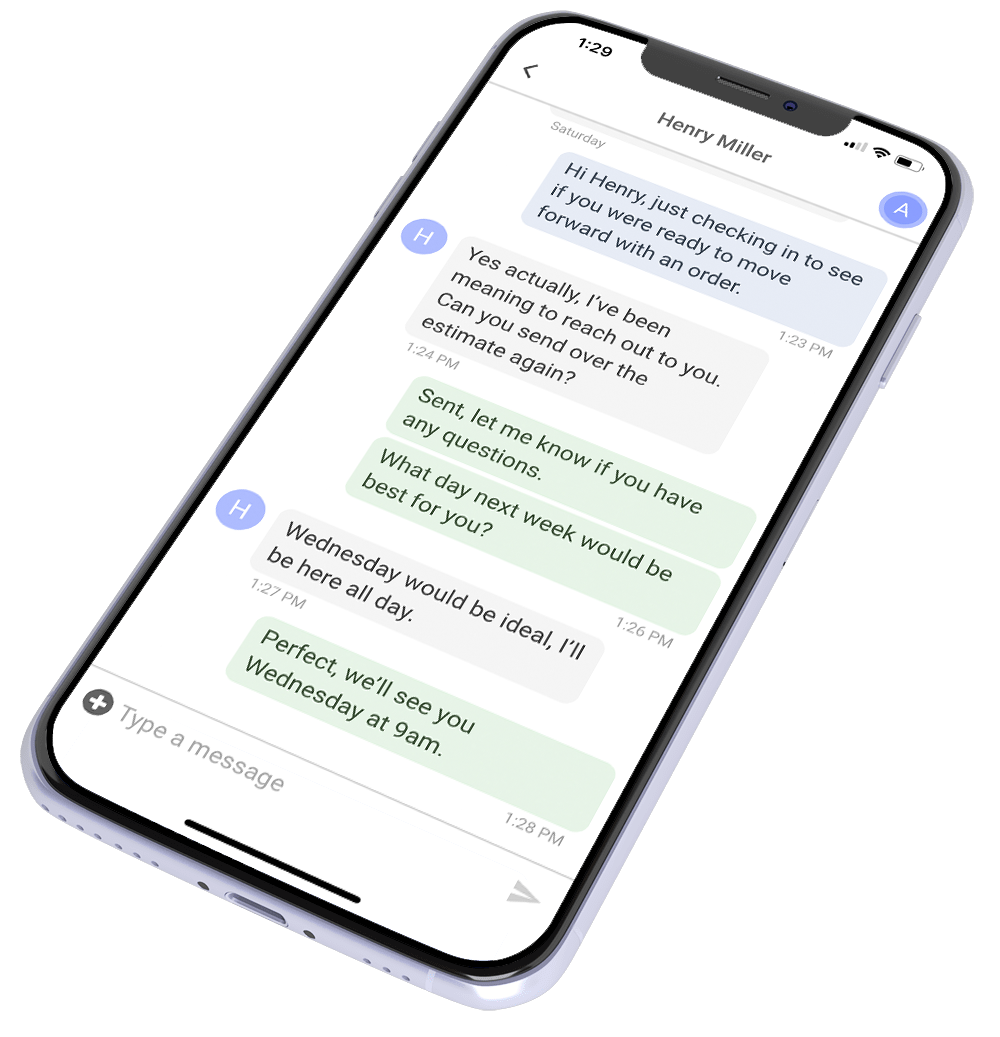Congrats! You just found your roofing lead generation playbook.
There is almost nothing more stressful than watching your lead count drop. Fewer inspections. Fewer sales. Especially when things were working before, and now your old strategies just aren’t hitting like they used to. It messes with your head.
You go from feeling like you’re on top of the world to suddenly wondering if you’ve lost your touch. Maybe you start to feel a little dumb. Maybe you feel like you don’t know what you’re doing anymore. It’s a bad place to be, and if you stay there too long, it only gets worse. You feel stuck.
And if you’re brand new, that stress shows up even faster. You haven’t found your rhythm yet, and you’ve got no clue how to get the ball rolling. You’re wondering where the leads come from, how this works, and if success in roofing is just random luck. You ask yourself, “What am I supposed to do here?” That kind of uncertainty can shut you down before you even start.
Here’s the good news: it’s not luck. The best roofers—the ones who consistently book jobs and stay busy—follow a common-sense playbook. It’s not complicated. It just works. And this article is going to walk you through it.
If you want more leads, better leads, and a repeatable way to keep the pipeline full, this is for you.

Lead Generation vs. Marketing
A lot of people mix up lead generation and marketing. It makes sense why: good marketing should eventually bring in leads, so the two feel connected. Think of marketing as the upstream effort that leads to lead generation downstream. It’s really easy to blur those lines, but if you zoom in, they’re not the same thing. Lead generation, in narrow terms, just means collecting contact information from people interested in your services.
Here’s how I think of it. Picture two circles: one for marketing, one for roofing lead generation. They overlap a little, but they’re not identical. For example, your website should collect contact info from homeowners who are interested—that’s lead generation. But it’s also marketing because it helps more people find you in the first place.
Same goes for something like an LSA ad or a Facebook ad offering a lead magnet or inspection. Those activities fall into both categories. But sponsoring a Little League event? That’s not really lead generation. You’re not walking around asking parents for their phone numbers at the ballfield. It’s marketing: it builds awareness and trust, which might lead to leads later.
Now flip that around. Let’s say you ask for referrals right at the point of sale. That’s not really marketing—you’re not promoting your business to strangers. But it is roofing lead generation because you’re asking for contact info from someone who already knows you. That person might give you the name of a neighbor or friend. And that’s a legit lead.
Quality vs. Quantity
A lot of people ask, “How do I get more leads for my roofing business?” And that’s a fair question. But sometimes it’s the wrong question. In many cases, it’s not about getting more leads—it’s about getting better ones. Chasing quantity without thinking about quality usually backfires.
Roofing lead generation isn’t just about collecting a long list of names. For example, you could offer a free guide on DIY car repairs and collect tons of email addresses. But if you’re a roofer, those names won’t help you sell a single roof. That’s because those people aren’t your customers. They’re just random contacts with no buying intent.
This is one of the big problems with buying lead lists. First off, tons of other roofers are buying those same lists. So now you’re in a mad dash to be the first to reach out. Second, you have no idea if those people are actually interested in your services. You’re just cold-calling strangers and hoping for the best.
So instead of chasing lists, focus on finding real homeowners who could want your services now—or sometime soon. The key is learning what those homeowners care about. What do they need? What are they actively looking for? That’s how you build a real lead generation process that actually works.
Identifying Your Ideal Customer
This part is way simpler than people think. Start by writing down a list of your most profitable jobs from the past year or so. Just jot down the name and address of each homeowner—nothing fancy. Then, make another list: the customers you actually liked working with. Think about the ones who didn’t give you a headache, maybe brought water bottles to the crew, or just made the job smooth.
Now look at both lists side by side. If you see any names on both? Bingo. Those are your ideal customers. They’re profitable and pleasant to work with. Those are the folks we want more of.
The next step is figuring out what those homeowners have in common. You want to start gathering basic details: are they married, do they have kids, what do you think their income is, how much is their home worth, how big is it, and what kind of neighborhood is it in? That stuff helps you target similar people. But don’t stop there—we need to go deeper. You also want to figure out what problems you helped them solve.
Now, when we talk about “emotional problems,” we don’t mean anything heavy like therapy-level issues. We’re talking about real frustrations or worries tied to their roof. Maybe they were scared of picking the wrong contractor and getting burned. Maybe they were embarrassed because they had the only ugly roof on the block. Or maybe they were afraid a bad roof would cost them money when it came time to sell.
Write those down. That’s gold. The more emotionally urgent the problem, the easier it is to sell the solution. You’re trying to sell water to someone whose house is on fire. And if you can solve part of their problem for free, even before they need a new roof—like with a free inspection or online tool—you’ve already earned trust and captured a future lead.
One more thing. Write down your customers’ beliefs. Split them into two groups: stuff they believe strongly that you shouldn’t challenge, and stuff they believe that you can challenge. If you push back on something they hold sacred—like politics or religion—they’ll tune you out. But if they believe roofing is too overwhelming and they’re bad at making decisions, that’s a belief you can help them shake. That makes them feel seen and supported.
Now that you’ve got a clearer picture of who these people are—their problems, their situations, and their beliefs—it’s time to take that knowledge and apply it. We’re going to walk through different roofing lead generation channels. We’ll start at the bottom of the funnel: people who need a roof right now. Then, we’ll work our way up to people who might not need a roof yet, but still make great leads. Some of these methods are free, some cost money, and I’ll flag that as we go.
Let’s dig into the best ways to get roofing leads.
SEO and Your Website
We’re including things like your Google Business Profile—formerly GMB—under this umbrella, because the truth is simple: people still use Google when they need to find a roofer. That’s not going away anytime soon. Even as AI becomes more popular for searching and researching, it still pulls from the internet. Whether someone’s using Google directly or asking ChatGPT for help, strong websites still win.
So, if your website ranks high, you’ll show up more in search results. And not just in Google—you’ll show up in AI answers too, since tools like ChatGPT crawl the web for information. That means a good website helps you get seen, no matter how someone’s searching. And if your website is strong enough to get someone to book an inspection or request a quote, you’re basically standing at the end of the hose, catching the water right before it hits the bucket. That’s as close to the sale as you can get.
Now, SEO is powerful, but it’s also a winner-take-all game. If you’re in a small town or a rural area, you can dominate quickly with just a little effort. But if you’re in a big city or facing national competitors, you’re going to need serious time and resources. Everybody’s fighting for the top three to five search results. And landing in spot number ten just isn’t going to cut it.
That said, there are things you can do no matter what market you’re in. Keep getting 5-star Google reviews. Regularly update your blog. Make sure your website loads fast, works on mobile, and has clear calls to action. Those small steps can help you compete—even if you’re not gunning for spot number one.
Google LSA Ads
Google Local Services Ads, or LSA, are a solid way to generate roofing leads. Our friend Scott Tebay, who runs Rainstoppers Roofing and uses ProLine, swears by them. For a while, he used message-only leads from LSAs and still saw strong results. These leads come from people actively searching for roofers, which means they’re usually pretty motivated. It’s a great way to get high-quality contact info from homeowners ready to make a move.
That said, LSAs come with strings attached. First, you’re relying on Google, which means you have to play by their rules. Second, Google tends to favor businesses with bigger budgets—even if you don’t spend your full daily cap, having a high ceiling helps. So if you’re not ready to invest, you might struggle to get visibility. Still, when it works, it works: you’re paying only for real leads, not clicks or impressions.
You also get the added bonus of that Google Guarantee badge. That gives homeowners peace of mind and helps you stand out at the very top of the results. It builds trust fast. And since these folks are already looking for a roofer, you’re getting them right at the edge of the buying decision. That’s what we mean when we say “the end of the hose.”
Door Knocking
Okay, hear me out. Door knocking has a terrible reputation, especially in storm-heavy markets. It’s hard. It’s awkward. It feels like something out of the Middle Ages, like you’re about to show up with a longbow and a trebuchet instead of a clipboard.
And yeah, we’re in the era of Google, digital marketing, and all things tech. But that’s exactly what makes door knocking so effective. It’s unexpected. In a world where people feel more isolated, a good, real human interaction can stand out. If you show up with honesty and kindness, very different from the scammy guys they’ve dealt with, you can win big.
The trick is having a strategy. Don’t just blanket entire neighborhoods. Instead, take this tip from Brad Akres—the guy’s a legend: when you schedule an inspection, leave door hangers on nearby homes. After the inspection, look to see who took them, then knock on those doors.
Keep it simple. Let them know you just inspected their neighbor’s roof. If you gave them a quote, mention it. If they signed, share that too. Then offer a free inspection on the spot and let them know you can quote them today.
Now, this isn’t the closest thing to the end of the hose. Some folks won’t need a roof at all, and that’s fine—you’re not trying to sell something they don’t need. But chances are, a few of them will need a roof soon, and the fact that you worked with their neighbor builds trust. You can also do this while you’re working on the actual job.
Let people nearby know it’s going to get a little noisy. Put out your yard signs. Park your wrapped trucks where they’re visible. Then, once the job’s done, knock doors again and offer those inspections. It’s a super low-cost, highly personal way to generate leads—and all you’re really investing is a few signs, a little time, and maybe a couple of door hangers.
Good Old-Fashioned Referrals
Referrals are, hands down, the best leads on the planet. We’ve talked about them a lot on this blog—and for good reason. They convert better, close faster, and cost nothing but a little effort. If you want the full deep dive, go check out our full referral generation guide. But for now, here are some quick tips to help you start crushing it.
First, timing is everything. Ask when the homeowner feels the most positive about you. That usually happens at a few key moments—when they sign the quote, during the post-job inspection, or even when you drop off materials. Catch them when they’re happy, and they’ll be much more likely to refer someone. That emotional high is where you strike.
Second, if you’re going to offer a reward, make it instant. Don’t promise $500 if the referral closes later. That’s too far down the road. Instead, give something they can use right away. A $50 Texas Roadhouse gift card will outperform a bigger, delayed reward every single time. People value quick wins.
Third, make your referral system consistent. Don’t wing it. Add it to your checklist. Mention it during your sales presentation. If you’re using ProLine, there’s even a referral portal built into the project portal, where customers can enter names and numbers right away.
That feature alone makes a huge difference. Referred leads get tagged immediately and enter your system ready to go. And while these might not be the most urgent leads, they come with a built-in trust factor. If Mrs. Smith trusted you with her roof, her friends and family are more likely to as well. You’ve already got your foot in the door—and that’s where great jobs start.
Roofing Social Media Lead Generation (Organic)
We’re going to split social media into two categories: organic and paid. They work differently, so it makes sense to treat them separately. And yes—you can absolutely generate real leads from organic social media. But there are a few things you have to nail first. It starts with offering rock-solid services and delivering a customer experience people want to rave about.
You’ve got to be a hometown hero. That doesn’t just come from how you sell—it comes from how you handle jobs after the quote gets signed. Your marketing needs to build trust, but your work needs to back it up. When you get this part right, something cool starts happening. People go into local Facebook groups and ask, “Hey, who do you trust for roof replacement?” and your name starts popping up again and again.
That’s the goal. You want to be the name that shows up every time someone asks. The way to get there is by doing great work and making people happy. But once that foundation is set, you can also nudge things along by incentivizing Facebook referrals. We go deeper into this in our referral guides, but the core idea is simple: make it easy and rewarding for customers to share their experience.
Here’s one example. After the job, ask if you can post a before-and-after photo of their roof. Then ask them to comment on the post or even share it to their own page. Or flip it—let them post about it, and you comment on their post. That kind of organic engagement can give you crazy reach, especially since most homeowners have a wider and more trusted local network than you do.
People trust other homeowners more than they trust roofers. That’s just how it is. If you brag about your business, they’ll stay skeptical. But if one of your customers says, “Hey, this company did a great job and I don’t hate them,” that means something. Done right, organic social gets you leads, drives traffic to your website, and gets your phone ringing without spending a dime.
Social Media Roofing Lead Generation (Paid)
Paid social media leads—like from Facebook or Instagram ads—tend to show up a little further up the hose, if that makes sense. They’re not always ready to buy right this second. That said, yes, Facebook ads can work for roofing. People ask that all the time, usually because they’ve run ads and gotten burned. But if you use them strategically, they 100% work.
The key is understanding how close someone is to making a buying decision. You can run ads offering free inspections, but timing and targeting are everything. For example, running them right after a big storm makes sense. Or keeping the ads super local—maybe targeting homes around a current job site. That tactic is called geofencing, and it’s a great way to stay relevant and visible in your service area.
But if you just start blasting inspection ads at everyone in town, you’ll burn through money fast. Most of those people won’t even need a roof. And if you annoy them enough, they’ll start tuning out your business entirely. So instead, think about how you can offer value up front, without immediately pushing the sale. That’s where lead form ads come in.
Here’s an old-school example: Michelin is a tire company, but they created the Michelin Guide—a rating system for restaurants. Why? Because the more people drove to eat, the more they needed new tires. You can apply the same logic. Instead of pushing roof inspections, offer something useful and related—like a guide for preparing your home for summer storms, or tips for winterizing before the first freeze.
Even lifestyle content works. A free download of “Top 10 Things to Do with Your Family This Month” might perform better than another inspection pitch. Because now you’re getting contact info and building a relationship. Add them to your email list and keep offering value—discounts, updates, local service referrals, or community partnerships. When they do need a roof, they’ll already know your name and trust your brand.
Don’t Let Roofing Lead Generation Go to Waste
So, all of the lead sources we’ve talked about—those are rock-solid. Every roofer should explore them. But here’s the thing: none of it matters if you mess up the basics. This is where a lot of roofers fall short. In fact, most could do less lead generation and still grow—if they just handled their leads better.
We’ve got full guides on this, including one on speed-to-lead that you should definitely read. But here’s the 30,000-foot view. The biggest mistake? Failing to follow up with new leads immediately. You need to be texting and emailing within seconds—definitely no later than five minutes.
That’s also when you should be calling. If they don’t answer, keep trying. Don’t just give up after one call or message. Build a system that keeps working those leads until they convert. This is exactly why ProLine CRM exists—to automate your follow-up and increase your close rate.
The second big mistake? Not tracking your roofing lead generation results. Different markets respond to different strategies. In one area, radio might kill it. In another, door knocking or digital campaigns might be your best bet. But you’ll never know unless you track everything.
You need to know where each lead comes from. You should be tagging leads by source, tracking how many book inspections, how many get quotes, and how many actually sign. You should also be tracking five-star reviews and referrals. Without that data, you’re flying blind—and there’s a real risk you’ll double down on the wrong strategy or miss what’s working. Track it all, or you’re dead in the water.
Conclusion
Roofing lead generation isn’t a joke. It’s one of the biggest challenges that holds roofing companies back—and for good reason. But if you follow the tips in this article, you’ll start seeing real progress. When you know exactly who your customer is, choose the right lead sources, and follow up consistently, you’ll get better results. And honestly, you’ll find that you don’t need a ton of leads if you’re handling the ones you get the right way.
Lead generation works best when it’s strategic. You’re not just tossing bait in the water—you’re fishing with the right lure, in the right spot, at the right time. And if you’re not following up with every lead, you’re leaving money on the table. That’s where a tool like ProLine can make all the difference. It keeps follow-up automatic, consistent, and effective so you can close more jobs.
If you want to see how ProLine can help you follow up better, book a demo.
You can also check out our overview video to learn more about how it works. And if you’re shopping around, don’t miss our full breakdown of the best roofing CRMs to see how ProLine stacks up. Roofers who take control of their leads close more jobs—plain and simple. Now you’ve got the playbook.




